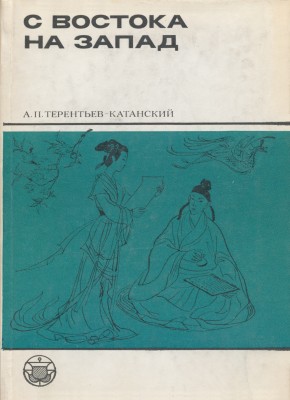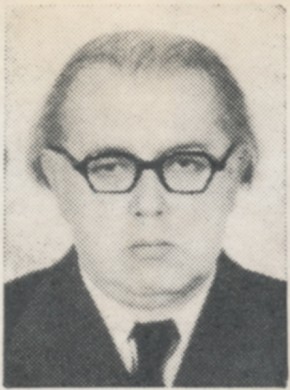 А.П. Терентьев-Катанский
А.П. Терентьев-Катанский
С Востока на Запад.
Из истории книги и книгопечатания
в странах Центральной Азии VIII-XIII вв.
[ аннотация: ]
В книге популярно изложена история развития книжного дела и книгопечатания в Центральной Азии. Рассказывается об изобретении бумаги, о системах письма, об оформлении и содержании древней восточной книги. На обширном фактическом материале автор освещает роль Центральной Азии в распространении книгопечатания с Востока на Запад. Для широкого читателя, а также для специалистов по палеографии.
Оглавление
У истоков (вместо предисловия). — 5
1. Запечатлённая мысль. — 5
2. Далёкие дороги. — 11
Глава первая. Как это делалось. — 18
1. Первая бумага в мире. — 18
2. Как изготовлялась древняя бумага. — 22
3. Центральноазиатская бумага VI-XIII вв. — 26
4. Путь бумаги на Запад. — 31
5. Краска для письма и печатания. — 34
6. Инструменты для письма и доски для печатания. — 38
7. Клей. — 40
8. Форма центральноазиатской книги. — 40
Глава вторая. Письмена — лицо культуры. — 57
1. Вдоль чёрных строк. — 57
2. Китайское письмо. — 59
3. Киданьское письмо. — 66
4. Тангутское письмо. — 70
5. Чжурчжэньское письмо. — 77
6. Сирийское письмо. — 80
7. Манихейское письмо. — 82
8. Согдийское письмо. — 83
9. Уйгурское письмо. — 84
10. Монгольское письмо. — 85
11. Тюркское руническое письмо. — 87
12. Западноиранские и арабские тексты, найденные в Центральной Азии. — 87
13. Индийское письмо. — 88
14. Тибетское письмо. — 91
15. Редкие и неотождествлённые системы письма. — 93
16. Квадратные письмена. — 95
Глава третья. Великое изобретение. — 117
1. Что было вначале. — 117
2. Накануне нового шага. — 120
3. Возникновение книгопечатания. — 127
4. Книгопечатание в Восточном Туркестане. — 131
5. Книгопечатание в Тибете. — 132
6. Книгопечатание у киданей и чжурчжэней. — 133
7. Книгопечатание у тангутов. — 134
8. Книгопечатание у ранних монголов. — 135
9. Подвижный шрифт. — 136
10. Спутники великого изобретения. — 137
Глава четвёртая. Где же тайны? — 141
1. Как же все-таки обстоит дело? — 141
2. Буддийский канон. — 142
3. Духовная поэзия. — 144
4. Дидактическая литература. — 146
5. Утопическая литература. — 146
6. Гадательные и магические тексты. — 147
7. Обращения к божествам. — 149
8. Конфуцианская и даосская литература. — 150
9. Календари. — 154
10. Медицинские сочинения. — 155
11. Историческая литература. — 156
12. Словари. — 157
13. Художественная литература. — 159
Глава пятая. Пёстрые листы. — 162
1. Художник и книга. — 162
2. Книжная иллюстрация. — 163
3. Виньетки. — 185
4. Рамки. — 188
5. Цветные надписи. — 188
Путь на Запад (вместо послесловия). — 190
1. Как книгопечатание стало достоянием всего мира. — 190
2. Первые сведения о восточном книгопечатании у европейских авторов. — 192
Примечания. — 196
Указатель имён. — 223
Указатель названий сочинений. — 225
[ Вклейка с фотоиллюстрациями, 4 л. — между стр. 160-161 ]
Список сокращений. ^
БВ — Библиография Востока.
КСИНА — Краткие сообщения Института народов Азии АН СССР.
ЛО ИВАН — Ленинградское отделение Института востоковедения АН СССР.
Монг. ф. — Монгольский фонд Рукописного отдела ЛО ИВАН.
НАА — Народы Азии и Африки. История, экономика, культура. М.
ППВ (ежегод.) — Письменные памятники Востока. Историко-филологические исследования. Ежегодник. М.
ПС — Палестинский сборник. М.-Л.
СВ — Советское востоковедение. М.-Л.
Сир.ф. — Сирийский фонд Рукописного отдела ЛО ИВАН.
СТ — Советская тюркология. Баку.
Тиб.ф. — Тибетский фонд Рукописного отдела ЛО ИВАН.
Т.ф. — Тангутский фонд Рукописного отдела ЛО ИВАН.
УЗИВАН — Учёные записки Института востоковедения АН СССР.
Яп.ф. — Японский фонд Рукописного отдела ЛО ИВАН.
AM — Asia Major. L. (Lpz.).
BSOAS — Bulletin of the School of Oriental (and African) Studies, London Institution (University of London).
CAJ — Central Asiatic Journal. The Hague — Wiesbaden.
JA — Journal asiatique. P.
JAOS — Journal of the American Oriental Society. New York-New Haven.
JRAS — Journal of the Royal Asiatic Society of the Great Britain and Ireland. L.
MS — Monumenta Serica: Journal of Oriental Studies of the Catholic University of Peking.
TP — T’oung Pao, ou Archives concernant l’histoire, les langues, la géographie, l’ethnographie et les arts de l’Asie Orientale. Paris — Leiden.
Summary. ^
A.P. Terentyev-Katansky. From the East Westward. The book deals with the emergence of book printing in the East and its spread westward. Terentyev-Katansky draws of the fundamental works of T.F. Carter (The Invention of Printing in China and its Spread Westward. N.Y., 1925) and K.K. Flug. (The History of Chinese Printed Book of the Sung Epoch: 10th-13th Centuries. Moscow-Leningrad, 1959), essentially complementing them with the new factual material mainly from the Manuscript Fund Collection of the USSR Academy of Sciences’ Institute of Oriental Studies (Leningrad) and the original early Chinese treatises on book making.
Most archaeological findings shedding new light on the emergence of books and book printing come from Central Asia which, because of its favourable geographic situation, had been a couldron where various ancient Oriental and Western cultures melted.
For a long time Central Asia was unknown to European researchers. Archaeological studies of the region reached their climax only in the 19th century. Much had been done by the expeditions of the Russian Geographic Society and the Russian Committee for Central and East Asia. V.I. Roborovsky was one of the first scholars who paid attention to Central Asian antiquities. In the ruins of the ancient Uighur capital he found many manuscripts and brought them to Russia. N.F. Petrovsky, the Consul General at Kashgar, made large collections of artworks and manuscripts. The expedition of D.A. Klements negotiated the route mapped out by Roborovsky. It visited 15 additional sites and retrieved rich material, including manuscripts, mainly Uighurian. The Manuscript Fund keeps the Central Asian collections of M.M. Berezovsky, N.N. Krotkov, S.Ye. Malov, and N.I. Kokhanovsky.
The Dunhuang library was a remarkable archaeological discovery of the first half of the 20th century. It was studied by many expeditions, including P. Pelliot’s from France and S. Oldenburg’s from Russia.
The materials collected by Russian expeditions in Central Asia show the diversity of the local forms and types of hand-
(228/229)
written and printed books, writing stuffs and various writing systems used to write and print books.
For a long time the Central Asians wrote on fabric, birch-bark, leather and, most often, on the wooden tablets. The tablets were binded with cords or straps in a roll. Birchbark writing was derived from India where it had been used even prior to the expeditions of Alexander the Great. Silk rolls were also used for writing.
The invention of paper is ascribed to the Chinese official Tsai Lun, who in 105 A.D. made it from a pulp of fabric, wooden bark, hemp and old fishing nets. Later various kinds of paper made of diverse stuffs appeared in China.
For a long time there was no change in the techniques of paper making: the pounded and boiled mass of hemp, bamboo fiber or ricestraw was poured down into a rectangular sieve with a fine meshwork. Then the sheet of paper was dried, whitewashed, or coloured.
Terentyev-Katansky describes the Dunhuang, Tangut, Uighur, Churcheng, Central Asian, Arab and Syrian paper.
In the Orient Indian ink was used for writing from early times. It was made from the soot of burned vegetable oils carefully mixed with gum and was particularly suitable for block printing (xylography). Metalplate printing and typing required dissolving the ink pigment in a greasy substance so as to grease the metal surfaces.
The first book writing instruments were a brush and a cane pen. Different varieties of wood were used for woodplate printing. This process is detailed in the section relating to the history of book printing.
Various types of Oriental books are described such as rolls, accordions, folios, butterflies, pothi, and sewn books, as well as various systems of pagination, forms of binding, section marks and the techniques of book restoration.
Terentyev-Katansky considers various systems of writing used in Central Asian books: hieroglyphics, primarily Chinese, from pictorials on ancient ceramics to modern hieroglyphs and cursive; the Kidan, Tangut and Churcheng hierogliphics; alphabetic systems such as the Central Asian version of the Syrian alphabet, the Manichaean, Sogdian, Uighur and Mongolian scripts; the Turkic runes, the Indian Central Asia alphabets such as the Kharoshthi, Brahmi, Lanja, and the Tibetan; rare and unidentified writing systems. Square graphics of different Oriental writing systems are examined. The conclusion is made that square graphics as a form of gala writing evolved in the Far East and Central Asia.
The description of the inception of book printing starts with
(229/230)
a review of the earliest techniques of mechanical copying: stamps, patterns, estampage. The idea of woodprinting using a large set of characters and the technique of making estampages from stone-carved inscriptions developed into xylography. The earliest printed books were found in Central Asia. In the 11th century an attempt was made in China to use a set of types but it did not become popular in the Orient. Xylography became very common in China, Eastern Turkestan, among the Kidans, the Churchengs, the Tanguts and the Mongols. The xylographic printing of paper money and playing cards is considered.
The study examines the contents of Central Asian early printed books. Terentyev-Katansky lists down the writings of the Buddhist, Confucian and Dao canons in different Central Asian languages, the temporal poetry, didactic, Utopian, chiromantic and magical literature, historical writings, wordbooks, the astronomy and calendar charts kept at the Manuscript Fund.
Finally the description is given of the artistic make-up of Central Asian books. Illustrations to Central Asian books, very different in style and artistic technique, are mainly of the Buddhist character, but they show not only the images of Buddhas, deities and saints, but also the portraits of people who donated to book printing, and the images of animals. Books are decorated with vignettes and, sometimes, with vignetted lines.
The afterword shows the relationship between Oriental and early European book printing and the former’s spread westward. The book concludes with a story of how the first information of the Oriental book printing reached Europe.
 ^ [ на обороте обложки: ]
^ [ на обороте обложки: ]
Анатолий Павлович Терентьев-Катанский родился в 1934 г. В 1958 г. окончил Восточный факультет Ленинградского государственного университета.
Многие годы А.П. Терентьев-Катанский занимался исследованием тангутских рукописей и ксилографов, хранящихся в Рукописном отделе Ленинградского отделения Института востоковедения АН СССР. В 1973 г. он защитил кандидатскую диссертацию по истории тангутской книги. А.П. Терентьев-Катанский — автор около 30 статей, посвящённых различным аспектам истории восточной книги, восточной палеографии, а также монографии «Книжное дело в государстве тангутов». В работах А.П. Терентьева-Катанского восточная книга рассматривается как источник сведений не только о духовной, но и материальной культуре народов.
|